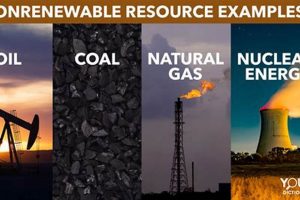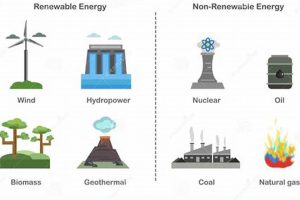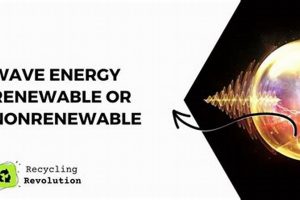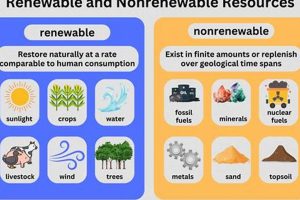Earth’s internal heat, accessible through various geological formations, offers a significant energy source. This heat can manifest as readily available steam or hot water, utilized directly for heating applications or to drive turbines for electricity generation. Alternatively, deeper, less accessible heat can be tapped via enhanced geothermal systems (EGS). The sustainability of harnessing this energy depends largely on the balance between extraction and replenishment rates. When extraction outpaces replenishment, the resource can be depleted locally, effectively rendering it non-renewable on a human timescale. Conversely, when managed sustainably, with extraction rates balanced or exceeded by natural recharge, the resource behaves as renewable.
Tapping Earth’s heat offers several advantages. It provides a consistent, baseload power source unaffected by diurnal or seasonal variations, unlike solar and wind power. Geothermal power plants possess relatively small footprints compared to other energy facilities and produce minimal greenhouse gas emissions. Historically, geothermal energy has been utilized for centuries in various cultures, from bathing and heating to rudimentary industrial processes. Modern utilization for electricity production began in the early 20th century and continues to evolve with advancements in drilling and power generation technologies. The potential for geothermal energy remains largely untapped, offering a substantial contribution to future energy portfolios.
The following sections delve deeper into the specific characteristics that determine the renewable or non-renewable nature of geothermal resources, explore different geothermal technologies, and analyze the environmental and economic impacts of this energy source. Further discussion will cover the global distribution of geothermal resources, current utilization levels, and the future potential of this valuable energy source.
Tips for Understanding Geothermal Sustainability
Evaluating the sustainability of geothermal energy projects requires careful consideration of several factors. The following tips offer guidance for assessing whether a specific geothermal operation aligns with renewable energy principles.
Tip 1: Resource Assessment: Conduct thorough geological surveys to determine the size, temperature, and recharge rate of the geothermal reservoir. Accurate resource assessment is crucial for sustainable management.
Tip 2: Extraction Rate: Limit the extraction rate of geothermal fluids to a level at or below the natural recharge rate. This ensures long-term resource viability.
Tip 3: Reinjection: Implement reinjection strategies to return spent geothermal fluids back into the reservoir. Reinjection helps maintain reservoir pressure and minimizes subsidence.
Tip 4: Reservoir Management: Employ advanced reservoir management techniques to optimize fluid flow and minimize thermal drawdown. Careful management prolongs the lifespan of the geothermal resource.
Tip 5: Environmental Monitoring: Implement robust environmental monitoring programs to track potential impacts, such as seismicity, land subsidence, and changes in water quality. Proactive monitoring enables timely mitigation measures.
Tip 6: Technological Advancements: Explore and adopt advanced geothermal technologies, such as Enhanced Geothermal Systems (EGS), to access deeper and hotter resources while minimizing environmental impacts.
Tip 7: Policy and Regulation: Advocate for and adhere to responsible policies and regulations that promote sustainable geothermal development and resource management.
By considering these factors, stakeholders can contribute to the responsible and sustainable utilization of geothermal energy, maximizing its benefits while minimizing potential environmental impacts.
The concluding section offers a synthesis of the key aspects discussed, emphasizing the critical role of sustainable practices in harnessing the Earths heat for the benefit of present and future generations.
1. Resource Replenishment Rate
Resource replenishment rate is a critical factor in determining whether a geothermal system can be considered renewable. It represents the speed at which the geothermal reservoir, the source of heat, recovers its thermal energy after extraction. This rate is governed by complex geological processes, including the flow of underground water and the conduction of heat from deeper within the Earth.
- Natural Recharge:
Natural recharge refers to the replenishment of geothermal fluids (water and steam) within the reservoir. This process is primarily driven by precipitation infiltrating the ground and migrating towards the heat source. High permeability of the surrounding rock formations facilitates efficient recharge. Areas with active volcanic activity often exhibit high natural recharge rates. Conversely, regions with limited precipitation and low permeability demonstrate slower recharge, potentially hindering sustainable geothermal energy production.
- Heat Conduction:
Heat conduction from the Earth’s interior contributes to the long-term sustainability of geothermal resources. The rate of heat conduction depends on the temperature gradient and the thermal conductivity of the surrounding rocks. While heat flow from the Earth’s core is continuous, the rate at which it reaches accessible depths can be relatively slow. This underscores the importance of balancing extraction rates with the natural influx of heat to maintain reservoir temperature and pressure.
- Extraction Rate vs. Replenishment Rate:
The relationship between extraction and replenishment rates is paramount for geothermal sustainability. If the extraction rate exceeds the replenishment rate, the reservoir temperature and pressure decline, leading to reduced energy output and potentially rendering the resource non-renewable over time. Conversely, maintaining extraction rates at or below the replenishment rate ensures the long-term viability and renewable nature of the geothermal resource. Careful management of extraction rates is therefore crucial for sustainable geothermal development.
- Reservoir Characteristics:
The geological characteristics of the reservoir significantly influence the replenishment rate. Factors such as reservoir size, porosity, permeability, and the presence of faults and fractures affect the flow of geothermal fluids and the transfer of heat. Large, highly permeable reservoirs with good connectivity to recharge zones generally exhibit higher replenishment rates. Accurate characterization of the reservoir is essential for assessing the long-term sustainability of a geothermal project.
Understanding and accurately quantifying the resource replenishment rate is fundamental for the sustainable management of geothermal resources. By balancing extraction rates with the natural replenishment processes, geothermal energy can provide a consistent and renewable source of power for generations to come. Failure to consider replenishment rates can lead to resource depletion and compromise the long-term viability of geothermal projects.
2. Extraction Rate Management
Extraction rate management plays a pivotal role in determining whether a geothermal resource can be considered renewable. The rate at which geothermal fluids (water and steam) are extracted from a reservoir directly impacts its long-term viability. Excessive extraction, exceeding the natural replenishment rate, leads to a decline in reservoir pressure and temperature. This, in turn, reduces energy output and can eventually deplete the resource, effectively rendering it non-renewable on a human timescale. Conversely, managing extraction rates at or below the natural recharge rate allows the reservoir to replenish, ensuring sustainable utilization and maintaining the renewable nature of the resource.
The consequences of mismanaged extraction rates are evident in several historical examples. The Geysers geothermal field in California, USA, experienced a significant decline in steam production during the 1980s due to excessive extraction. This decline necessitated the implementation of reinjection programs to maintain reservoir pressure and sustain power generation. Similar challenges have been observed in other geothermal fields globally, highlighting the critical importance of balancing extraction with recharge. Conversely, carefully managed geothermal fields, such as those in Iceland and New Zealand, demonstrate successful long-term sustainable operation by adhering to strict extraction limits and employing reinjection strategies.
Sustainable extraction rate management requires a detailed understanding of the geothermal reservoirs characteristics, including its size, permeability, and recharge rate. Sophisticated reservoir modeling techniques, coupled with continuous monitoring of pressure and temperature, are essential for optimizing extraction strategies. Implementing adaptive management practices, where extraction rates are adjusted based on real-time data, allows operators to respond dynamically to changes in reservoir conditions and maintain sustainable operation. The economic viability of a geothermal project is intrinsically linked to the long-term sustainability of the resource. By prioritizing responsible extraction rate management, geothermal energy can provide a reliable and renewable energy source for generations to come, contributing significantly to global energy security and mitigating climate change.
3. Technological Advancements
Technological advancements play a crucial role in enhancing the sustainability and expanding the accessibility of geothermal energy, thereby influencing its classification as renewable. Innovations in drilling technology, reservoir management, and power generation techniques contribute significantly to the efficient and sustainable utilization of geothermal resources. Advanced drilling technologies, such as directional drilling and enhanced geothermal systems (EGS), enable access to deeper and hotter geothermal reservoirs, expanding the potential for power generation. EGS, in particular, holds promise for accessing geothermal resources in areas previously considered unsuitable for conventional geothermal development. By fracturing hot, dry rocks deep underground and circulating water through them, EGS creates artificial geothermal reservoirs, potentially expanding the reach of geothermal energy significantly.
Furthermore, advancements in reservoir management techniques, including sophisticated modeling software and real-time monitoring systems, enable operators to optimize fluid flow and minimize thermal drawdown. These technologies contribute to sustainable resource management, ensuring that extraction rates remain balanced with natural recharge. Similarly, innovations in power generation technologies, such as binary cycle power plants, allow for efficient electricity generation from lower-temperature geothermal resources, further expanding the applicability of geothermal energy and enhancing its overall sustainability. Real-world examples illustrate the impact of these technological advancements. The development of supercritical geothermal systems, capable of operating at extremely high temperatures and pressures, promises to significantly increase power output from individual geothermal wells. Similarly, advancements in closed-loop geothermal systems, which circulate a working fluid within a closed loop, minimize environmental impact and reduce the risk of resource depletion.
The ongoing development and implementation of these and other technological advancements are essential for maximizing the potential of geothermal energy as a renewable resource. These innovations not only enhance the efficiency and economic viability of geothermal projects but also contribute to their long-term sustainability, ensuring that geothermal energy can play a vital role in the global transition to a cleaner and more sustainable energy future. However, continued research and development are necessary to overcome remaining technological challenges, such as mitigating induced seismicity associated with EGS and improving the cost-effectiveness of deep drilling techniques. Overcoming these challenges will be crucial for unlocking the full potential of geothermal energy and maximizing its contribution to a sustainable energy future.
4. Local Geological Conditions
Local geological conditions exert a profound influence on the viability and sustainability of geothermal energy extraction, directly impacting its classification as renewable or nonrenewable. The type of geothermal resource, its temperature, depth, and the permeability of surrounding rock formations are all dictated by local geology. These factors, in turn, influence the rate at which the resource can be replenished, a critical determinant of its renewable status.
High-temperature geothermal resources suitable for electricity generation are typically associated with volcanically active regions, where magma intrusions heat underlying rock formations and groundwater. Iceland, situated along the Mid-Atlantic Ridge, exemplifies this connection, boasting abundant geothermal resources due to its active volcanism. Conversely, regions with lower geothermal gradients, such as sedimentary basins, may offer lower-temperature resources suitable for direct heating applications but not electricity generation. The permeability of the surrounding rock formations plays a crucial role in geothermal fluid flow and reservoir recharge. Highly permeable formations facilitate efficient fluid circulation and enhance natural replenishment rates, contributing to the resource’s renewable nature. Conversely, low permeability restricts fluid flow, hindering recharge and potentially leading to resource depletion if extraction rates are not carefully managed.
The Enhanced Geothermal Systems (EGS) technology attempts to overcome geological limitations by creating artificial geothermal reservoirs in hot, dry rock formations. However, the success of EGS depends critically on understanding local geological conditions, including stress regimes and fault lines, to minimize the risk of induced seismicity. Understanding local geological conditions is paramount for sustainable geothermal development. Thorough geological surveys and resource assessments are essential prerequisites for any geothermal project to determine the resource’s characteristics, potential, and long-term sustainability. Failure to consider local geological factors can lead to inefficient resource utilization, environmental damage, and ultimately, the depletion of a potentially renewable resource.
5. Long-Term Sustainability
Long-term sustainability is inextricably linked to the classification of geothermal energy as renewable or nonrenewable. A geothermal resource’s ability to provide continuous energy output over extended periods, without significant environmental degradation, determines its long-term sustainability. This, in turn, hinges on the delicate balance between the rate of energy extraction and the natural replenishment rate of the geothermal reservoir. Sustainable practices, such as carefully managed extraction rates and reinjection of geothermal fluids, are essential for maintaining reservoir pressure and temperature, ensuring long-term productivity and classifying the resource as renewable. Conversely, aggressive extraction exceeding natural recharge rates can lead to resource depletion and environmental issues, rendering geothermal energy effectively nonrenewable in specific locations.
The Salton Sea Geothermal Field in California offers a compelling illustration. Initially, high extraction rates led to declining reservoir pressures and subsidence issues. Subsequent implementation of reinjection programs and stricter extraction limits helped stabilize the reservoir, improving long-term sustainability and reinforcing the renewable classification. Similarly, Icelands geothermal power plants demonstrate successful long-term sustainable operation through careful resource management, contributing significantly to the nation’s renewable energy portfolio. These examples highlight the direct impact of operational practices on long-term sustainability and the renewable status of geothermal energy.
Achieving genuine long-term sustainability with geothermal energy requires a holistic approach encompassing resource assessment, extraction management, environmental monitoring, and technological innovation. Accurate quantification of reservoir characteristics, including size, temperature, and permeability, is crucial for informed decision-making. Continuous monitoring of reservoir conditions, coupled with adaptive management strategies, allows operators to respond dynamically to changing conditions and maintain optimal extraction rates. Investing in research and development of advanced technologies, such as Enhanced Geothermal Systems (EGS), can unlock the potential of previously inaccessible resources while minimizing environmental impacts. Ultimately, recognizing the interdependence of these factors is essential for ensuring the long-term sustainability of geothermal energy and maximizing its contribution to a sustainable energy future.
6. Environmental Impact Assessment
Environmental Impact Assessment (EIA) plays a critical role in determining the sustainability of geothermal energy projects and, consequently, their classification as renewable or nonrenewable. A comprehensive EIA evaluates the potential environmental effects of geothermal development, including impacts on air and water quality, land use, seismicity, and local ecosystems. The assessment findings inform decision-making processes, ensuring that potential environmental risks are minimized and that geothermal development aligns with sustainable practices. A rigorous EIA is essential for classifying a geothermal project as truly renewable, as unsustainable practices can negate the inherent renewable nature of the geothermal resource itself.
- Induced Seismicity
Geothermal operations, particularly Enhanced Geothermal Systems (EGS), can induce seismic activity due to the injection and extraction of fluids into the subsurface. The magnitude and frequency of induced seismicity vary depending on local geological conditions and operational parameters. While most induced seismic events are minor, larger events can pose risks to infrastructure and public safety. Careful site selection, coupled with advanced monitoring and mitigation techniques, is crucial for minimizing the risk of induced seismicity and ensuring the sustainable development of geothermal resources.
- Land Use and Ecosystem Impacts
Geothermal power plants require land for wells, pipelines, and power generation facilities. Land use changes can impact local ecosystems, including vegetation, wildlife habitats, and water resources. Minimizing the project footprint, implementing effective land restoration practices, and carefully siting infrastructure to avoid sensitive ecological areas are crucial for mitigating land use and ecosystem impacts. Sustainable land management practices contribute to the overall renewable classification of geothermal projects.
- Water Quality and Usage
Geothermal fluids often contain dissolved minerals and gases, which can impact water quality if released into the environment. Reinjection of geothermal fluids back into the reservoir is a common practice to minimize water quality impacts and maintain reservoir pressure. Additionally, water usage for cooling purposes in geothermal power plants can strain local water resources, particularly in arid regions. Sustainable water management practices, including minimizing water consumption and treating wastewater before discharge or reinjection, are essential for ensuring the renewable nature of geothermal operations.
- Greenhouse Gas Emissions
While geothermal energy is generally considered a low-carbon energy source, some greenhouse gases, such as carbon dioxide and hydrogen sulfide, can be released during geothermal operations. The amount of greenhouse gas emissions varies depending on the type of geothermal resource and the specific technologies employed. Minimizing emissions through proper wellhead management and utilizing technologies to capture and sequester greenhouse gases contributes to the overall environmental performance of geothermal projects and reinforces their renewable status.
A thorough EIA considering these and other potential environmental impacts is crucial for ensuring the sustainable development of geothermal resources. By carefully evaluating and mitigating potential environmental risks, geothermal projects can genuinely contribute to a renewable energy future. Failing to address environmental concerns can lead to project delays, community opposition, and ultimately, compromise the long-term viability and renewable classification of geothermal energy development.
Frequently Asked Questions
This section addresses common inquiries regarding the renewable or nonrenewable nature of geothermal energy.
Question 1: Is geothermal energy always considered renewable?
Not necessarily. While geothermal energy utilizes a naturally occurring heat source, its classification as renewable depends on the sustainable management of the resource. If the rate of extraction exceeds the natural replenishment rate, the resource can be depleted locally over time, rendering it effectively nonrenewable on a human timescale. Sustainable practices are crucial for maintaining its renewable status.
Question 2: What factors influence the replenishment rate of a geothermal reservoir?
Several geological factors influence replenishment rates, including the local geothermal gradient, the permeability of surrounding rock formations, and the availability of groundwater recharge. Regions with active volcanism often exhibit higher replenishment rates compared to areas with lower geothermal activity.
Question 3: How does Enhanced Geothermal Systems (EGS) technology impact the renewable nature of geothermal energy?
EGS expands access to geothermal resources by enabling energy extraction from hot, dry rock formations. However, the long-term sustainability of EGS remains subject to ongoing research and development, focusing on minimizing induced seismicity and optimizing reservoir management to maintain renewable energy production over extended periods.
Question 4: What role does reinjection play in maintaining geothermal sustainability?
Reinjection, the process of returning extracted geothermal fluids back into the reservoir, plays a crucial role in maintaining reservoir pressure and minimizing subsidence. This practice helps sustain the resource and contributes to its renewable classification by promoting long-term productivity.
Question 5: How can one determine if a specific geothermal project is operating sustainably?
Indicators of sustainable geothermal operation include comprehensive resource assessments, carefully managed extraction rates aligned with natural recharge, robust environmental monitoring programs, and implementation of mitigation measures to address potential environmental impacts.
Question 6: What are the potential environmental impacts of geothermal energy production?
Potential environmental impacts associated with geothermal energy production include induced seismicity, land use changes, impacts on water quality and availability, and the release of greenhouse gases. Careful site selection, robust mitigation measures, and ongoing environmental monitoring are essential for minimizing these impacts.
Sustainable practices are essential for ensuring that geothermal energy remains a viable and renewable resource. Responsible resource management and continuous technological advancement contribute significantly to the long-term viability and environmental performance of geothermal energy projects.
The following section explores case studies of successful sustainable geothermal operations globally, highlighting best practices and lessons learned.
Geothermal Energy
The classification of geothermal energy as renewable hinges critically on the balance between resource extraction and replenishment. Exploration of this topic reveals that geological conditions, technological advancements, and, most importantly, operational practices dictate the long-term sustainability of geothermal resources. While Earth’s internal heat offers a vast and continuously replenished energy source, unsustainable extraction rates can lead to localized depletion, effectively rendering geothermal energy nonrenewable in specific areas. Careful resource management, including reinjection and adaptive extraction strategies, is therefore paramount for maintaining reservoir pressure and temperature, ensuring long-term productivity and justifying the renewable designation.
The future of geothermal energy as a significant contributor to a sustainable energy landscape depends on continued advancements in exploration, extraction technologies, and, crucially, a commitment to responsible resource management. Further research into induced seismicity mitigation and enhanced geothermal systems remains essential for expanding access to this valuable resource while minimizing environmental impacts. Ultimately, the long-term viability of geothermal energy as a renewable resource rests on a global commitment to sustainable practices, ensuring that Earth’s heat can continue to power generations to come.







